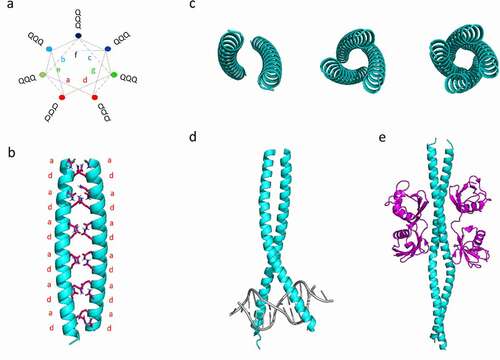Figures & data
Figure 1. Structural features of coiled-coils built up by Poly-Q repeats. a) Helical wheel illustration for a regular heptad pattern composed built up by 21 Gln residues. The Gln residues are found in all seven (a-b-c-d-e-f-g) positions of the heptad repeat due to the particular chemical nature of this amino acid. b) Modelled structure of a canonical CC composed of 42 Gln residues. c) Structural representation of the oligomerization states driven by the supercoiling of the α-helices in a parallel orientation. d,e) Examples of functional protein-DNA and protein-protein interactions mediated by CCs. d) X-ray crystal structure of the leucine zipper Pap1 bZIP dimer bound to DNA. e) Crystal Structure of a diUb chain bound to the NEMO-UBAN domain. PDB codes are: 1GD2 and 2ZVN for d) and e), respectively

Figure 2. TBP contains a Q-rich coiled-coil PrLD. a) Linear representation of human TBP, showing the location of the N-t Q-rich sequence and the pair of C-t TATA-box-binding domains. b) The predictions for the prion-like domain (red) identified using PLAAC (30) predictor. CC per-residue probability of TPB calculated using c) COILS [Citation9] and d) PARCOIL2 [Citation10]. d) Wheel representation of the heptad repeats (a-b-c-d-e-f-g) of TBP. The sequence corresponding to the soft amyloid core (SAC) of TPB predicted by pWALTZ [Citation45] is indicated
![Figure 2. TBP contains a Q-rich coiled-coil PrLD. a) Linear representation of human TBP, showing the location of the N-t Q-rich sequence and the pair of C-t TATA-box-binding domains. b) The predictions for the prion-like domain (red) identified using PLAAC (30) predictor. CC per-residue probability of TPB calculated using c) COILS [Citation9] and d) PARCOIL2 [Citation10]. d) Wheel representation of the heptad repeats (a-b-c-d-e-f-g) of TBP. The sequence corresponding to the soft amyloid core (SAC) of TPB predicted by pWALTZ [Citation45] is indicated](/cms/asset/2e0a3e8d-eb79-4352-958e-5946ef62ffa2/kprn_a_1961569_f0002_oc.jpg)
Figure 3. Human proteins containing PrLDs and overlapping CC regions. a-e) Linear representation of a) CBP, b) ATXN1, c) ATXN8, d) KMT2D, and e) FOXP2 showing the location of the Pfam domains (green) (3). The prion-like domains (red) based on PLAAC [Citation34] predictions (0.8–1 score) and the CC regions (yellow) using COILS [Citation9] predictor are indicated (0.8–1 score). In a-e), the COILS and PLAAC per-residue probability plots have been included. f) Linear representation of other human prion-like proteins with overlapping CCs. Note that the COILS score (> 0.3) has been considered for AAK1 and NFAT5
![Figure 3. Human proteins containing PrLDs and overlapping CC regions. a-e) Linear representation of a) CBP, b) ATXN1, c) ATXN8, d) KMT2D, and e) FOXP2 showing the location of the Pfam domains (green) (3). The prion-like domains (red) based on PLAAC [Citation34] predictions (0.8–1 score) and the CC regions (yellow) using COILS [Citation9] predictor are indicated (0.8–1 score). In a-e), the COILS and PLAAC per-residue probability plots have been included. f) Linear representation of other human prion-like proteins with overlapping CCs. Note that the COILS score (> 0.3) has been considered for AAK1 and NFAT5](/cms/asset/71b5c347-68f6-4c27-99fd-46673744f0da/kprn_a_1961569_f0003_oc.jpg)
